 |
 |
 |
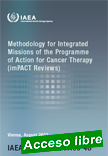 |
Methodology for Integrated Missions of the Programme of Action for Cancer Therapy (imPACT Reviews)
IAEA Services Series No. 46 ¦ English ¦ 34 pages ¦ 6 figures ¦ Date published: 2022
The objective of this publication is to describe the methodology of the imPACT Review and its data collection tools in a structured and comprehensive manner. This framework is intended to be used along the cancer control continuum and tailored to the specific needs of the requesting Member State.
|
. It may also be used as a tool for a cancer specific needs assessment and as a resource for the most up-to-date, evidence-based guidelines from IAEA, IARC and WHO in relation to cancer control planning and delivery.
|
 |
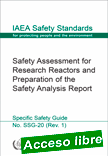 |
Safety Assessment for Research Reactors and Preparation of the Safety Analysis Report
IAEA Safety Standards Series No. SSG-20 (Rev. 1) ¦ English ¦ STI/PUB/1981 ¦ 129 pages ¦ Date published: 2022
This Safety Guide provides recommendations on the safety assessment for research reactors in the authorization process, and on performance of safety analysis and preparation of the safety analysis report. It also incorporates the relevant lessons learned from the accident at the Fukushima Daiichi nuclear power plant and elaborates guidance on interfaces between nuclear safety and nuclear security.
|
The recommendations in this Safety Guide are intended for operating organizations of research reactors; it can also be used by designers performing a safety assessment for a research reactor. Furthermore, this guide provides useful guidance for regulatory bodies performing a review and assessment of submitted safety analysis reports as an important document within authorization process. This Safety Guide is a revision of IAEA Safety Standards Series No. SSG-20, which it supersedes.
|
 |
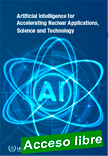 |
Artificial Intelligence for Accelerating Nuclear Applications, Science and Technology
IAEA/ART/INT ¦ English ¦ 98 pages ¦ Date published: 2022
Artificial intelligence (AI) methods have had significant impacts in science and technology in recent years. These methods for generating models from datasets or logic-based algorithms that emulate aspects of human performance can similarly accelerate the fields of nuclear applications, science, and technology toward the IAEA goals of contributing to peace, health, and prosperity.
|
This publication provides a review of the current state of the art, outlines challenges and identifies priorities for future AI activities in the nuclear field and the IAEA's role to support their accomplishment. The uses of AI in the fields of nuclear sciences and applications, nuclear power, nuclear safety and security and safeguards verification, are considered. There is also a dedicated chapter on ethics pertinent to AI in the nuclear field.
|
 |
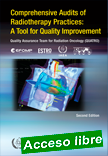 |
Comprehensive Audits of Radiotherapy Practices: A Tool for Quality Improvement
IAEA ¦ English ¦ STI/PUB/1990 ¦ 119 pages ¦ Date published: 2022
On request, the IAEA performs comprehensive audits of radiotherapy programmes to assess the whole process, including aspects such as organization, infrastructure and clinical and medical physics components. The objective of a comprehensive clinical audit is to review and evaluate the quality of all components of the practice of radiotherapy at the institution, including its professional competence, with a view to quality improvement.
|
A multidisciplinary team, known as Quality Assurance Team in Radiation Oncology (QUATRO), comprising a radiation oncologist. a medical physicist and a radiation therapist, are required to carry out the audit. The present publication provides revisions of the QUATRO guidelines published in 2007, by incorporating new procedures relevant to newer technologies and modalities that have become routinely used in radiotherapy centres in the interim period.
|
 |
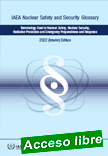 |
IAEA Nuclear Safety and Security Glossary: Terminology Used in Nuclear Safety, Nuclear Security, Radiation Protection and Emergency Preparedness and Response
IAEA/NSS/GLO ¦ 246 pages ¦ 6 figures ¦ Date published: 2022
The IAEA Nuclear Safety and Security Glossary, 2022 (Interim) Edition, defines and explains technical terms used in IAEA safety standards and nuclear security guidance and other safety and security related IAEA publications, and provides information on their usage.
|
It includes terms and definitions that have been established in IAEA safety standards and nuclear security guidance issued and approved up to 2022. The primary purpose of the publication is to promote consistency of terminology and usage. The glossary provides guidance for drafters and reviewers of safety standards, nuclear security guidance and other publications and is a source of information for users of these publications.
|
 |
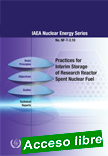 |
Practices for Interim Storage of Research Reactor Spent Nuclear Fuel
IAEA Nuclear Energy Series No. NF-T-3.10 ¦ English ¦ STI/PUB/2007
This publication provides an introduction to the management of research reactor spent nuclear fuel (RRSNF). Five key areas are discussed: types of RRSNF, characterization data, wet storage considerations, dry storage considerations, and lessons learned and current practices.
|
Information on internationally accepted standards as well as information on aspects such as drying treatment and surveillance programmes are presented, as well as suggestions for further optimization of effective and safe storage of RRSNF through the application of new approaches. The intended users of this publication include industry professionals at operating research reactors and at RRSNF storage facilities who need to identify the most suitable approach for interim storage of spent fuel.
|
 |
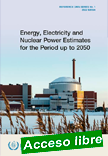 |
Energy, Electricity and Nuclear Power Estimates for the Period up to 2050 - 2022 Edition
IAEA-RDS-1/42 ¦ Reference Data Series No. 1 ¦ English ¦ 137 pages ¦ 61 figures ¦ Date published: 2022
The 42nd edition of RDS-1 contains estimates of energy, electricity and nuclear power trends up to the year 2050. The publication is organized into world and regional subsections, with global and regional nuclear power projections presented as low and high cases, encompassing the uncertainties inherent in projecting trends.
|
.
|
 |
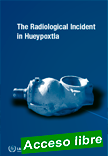 |
The Radiological Incident in Hueypoxtla
IAEA/RAD/INC ¦ English ¦ 48 pages ¦ 11 figures ¦ Date published: 2022
In the early morning of 2 December 2013, a vehicle transporting a radiotherapy machine head containing a category 1, cobalt-60 radioactive source was stolen, resulting in radiation exposure to members of the public. This publication provides information about the circumstances of the incident and the response actions taken by the Mexican authorities, including dose assessments performed to identify the individuals exposed.
|
Observations and lessons identified are presented. The publication also describes the actions taken by the IAEA.
|
 |
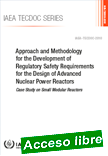 |
Approach and Methodology for the Development of Regulatory Safety Requirements for the Design of Advanced Nuclear Power Reactors
IAEA-TECDOC-2010 ¦ English ¦ 66 pages ¦ 7 figures ¦ Date published: 2022
Proposing a stepwise, technology neutral approach and methodology for the development and adaption of regulatory safety requirements for the design of advanced nuclear power reactor technologies, this publication aims to support decision making by national regulatory authorities.
|
It is based on integrated risk-informed, objective-oriented, performance-based approaches. A particular focus is placed on small and medium sized and modular reactor (SMR) designs. The publication identifies and exemplifies the key design features of SMRs to be considered important for the process of development or updating the regulatory safety requirements. The information presented is based on the experience provided by technical experts from Member States which have conducted the review of the adequacy of the set of regulatory requirements to the advanced nuclear power reactor technologies, and particularly for SMR designs.
|
 |
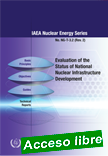 |
Evaluation of the Status of National Nuclear Infrastructure Development
IAEA Nuclear Energy Series No. NG-T-3.2 (Rev.2) ¦ English STI/PUB/2001 ¦ 97 pages ¦ 83 figures ¦ Date published: 2022
This publication provides a holistic approach to evaluate progress in the development of a nuclear power infrastructure based on the guidance contained in IAEA Nuclear Energy Series No. NG-G-3.1, Milestones in the Development of a National Infrastructure for Nuclear Power.
|
It is intended to support Member States in their progress evaluation, or as a basis for an IAEA Integrated Nuclear Infrastructure Review (INIR) mission. While Phases 1 and 2 of nuclear power infrastructure development are contained in the previous editions, evaluation methodology and conditions for Phase 3 have been added to this revision, using the feedback and lessons learned from its application in two pilot INIR Phase 3 missions.
|
 |
| |
|
|

|
|
|
| |
|
|
| |
| |
|
|
| |
| |
|
|
| |
| |
|
|
|
| |
| |
